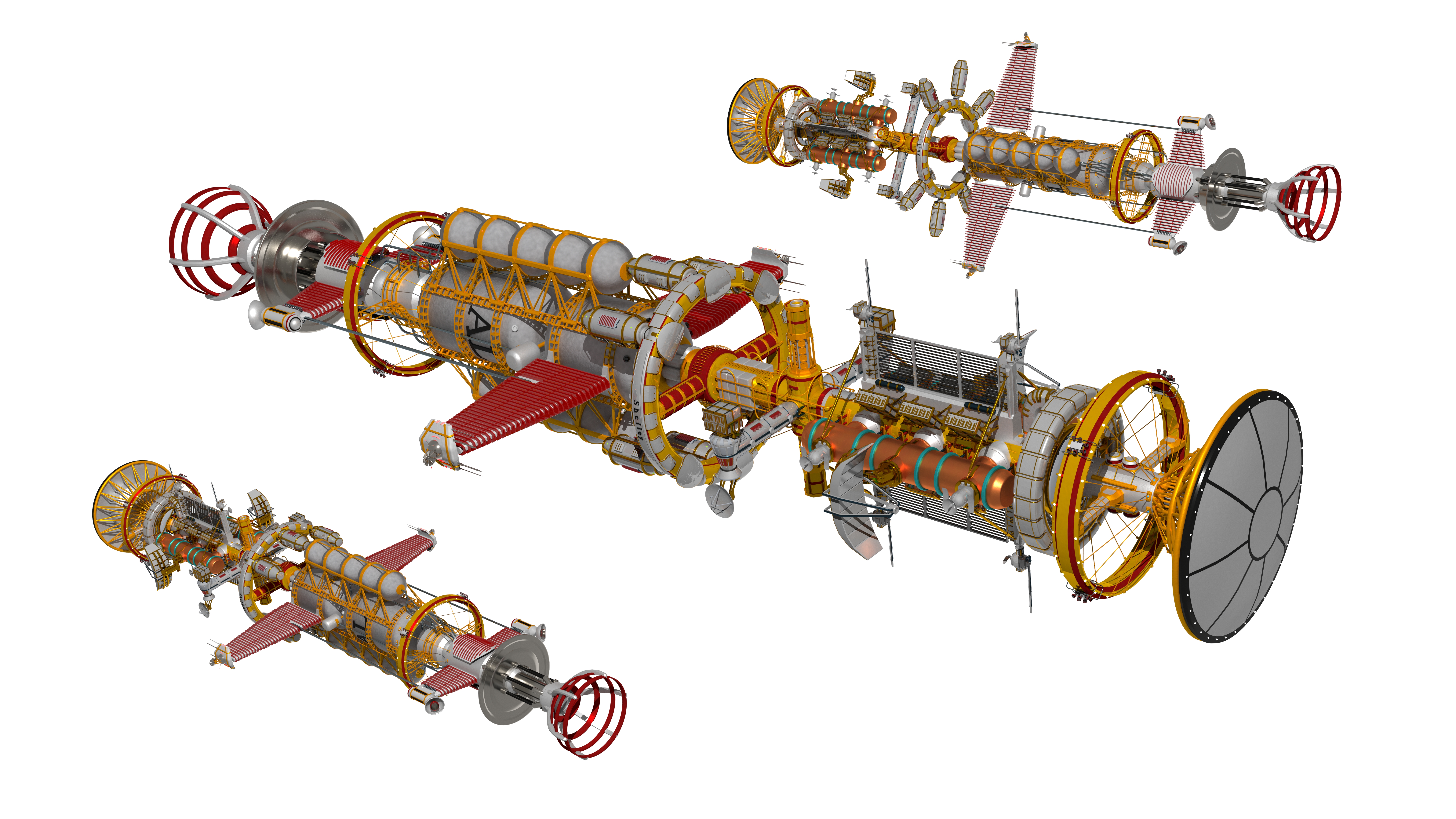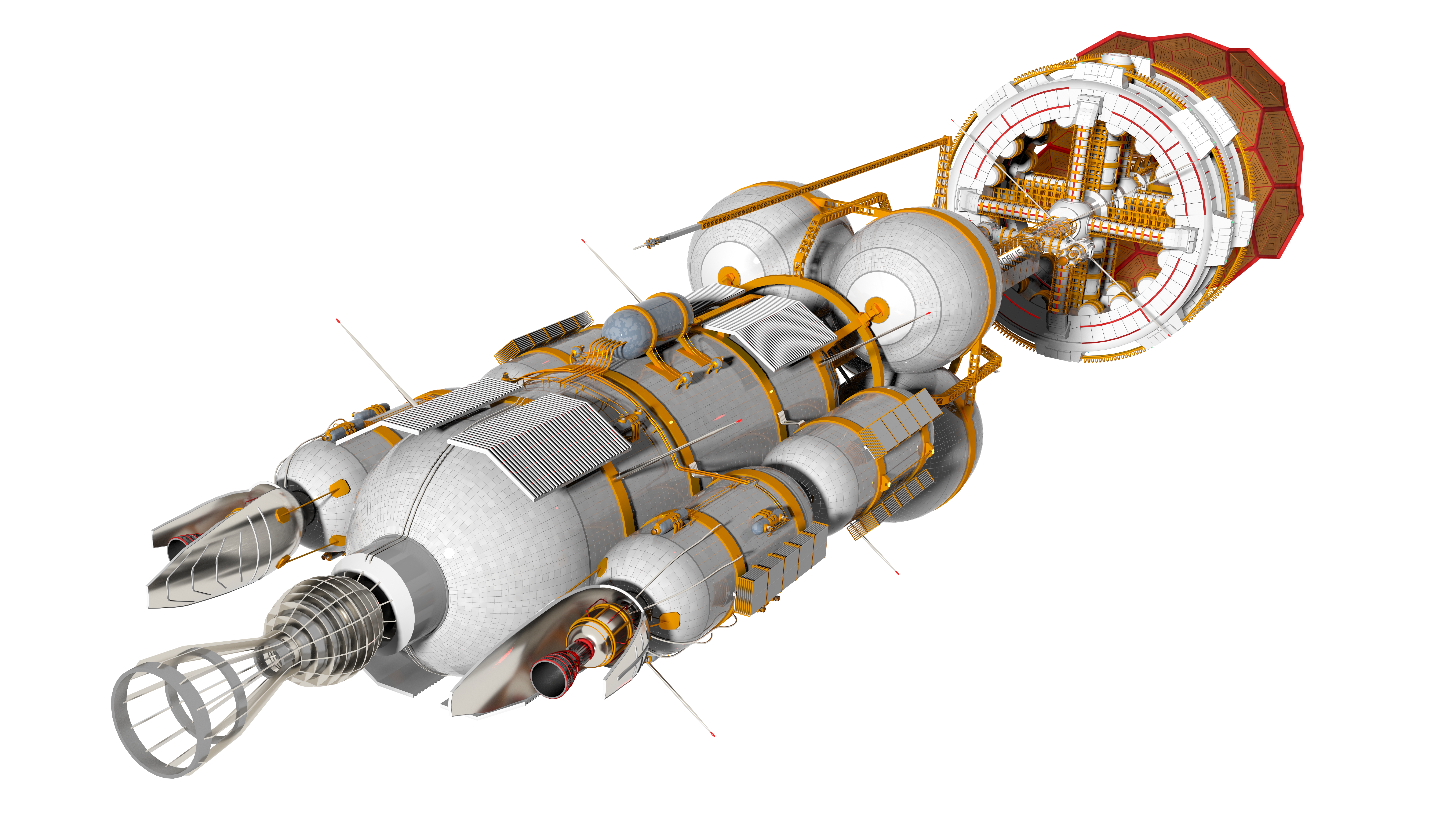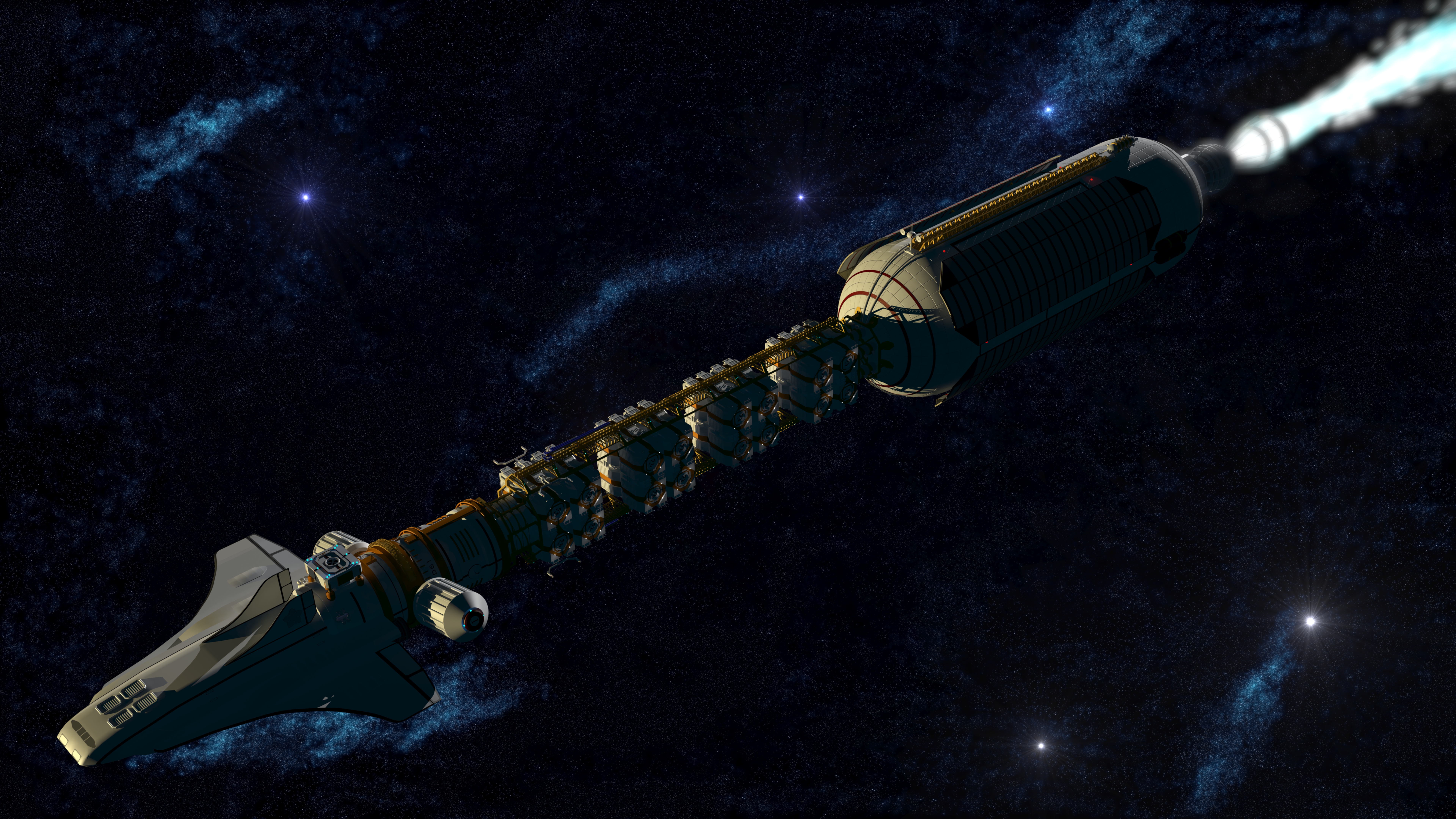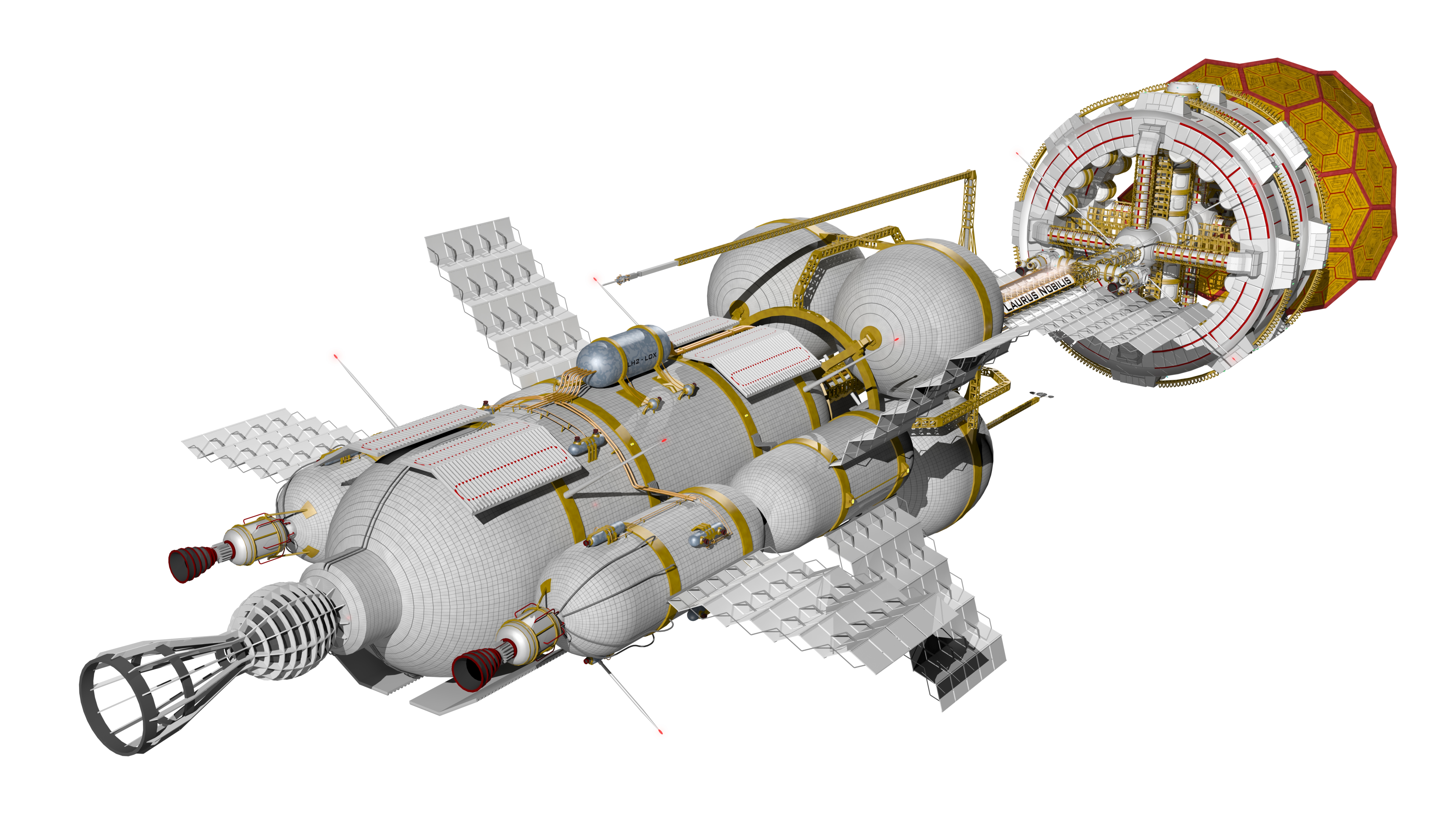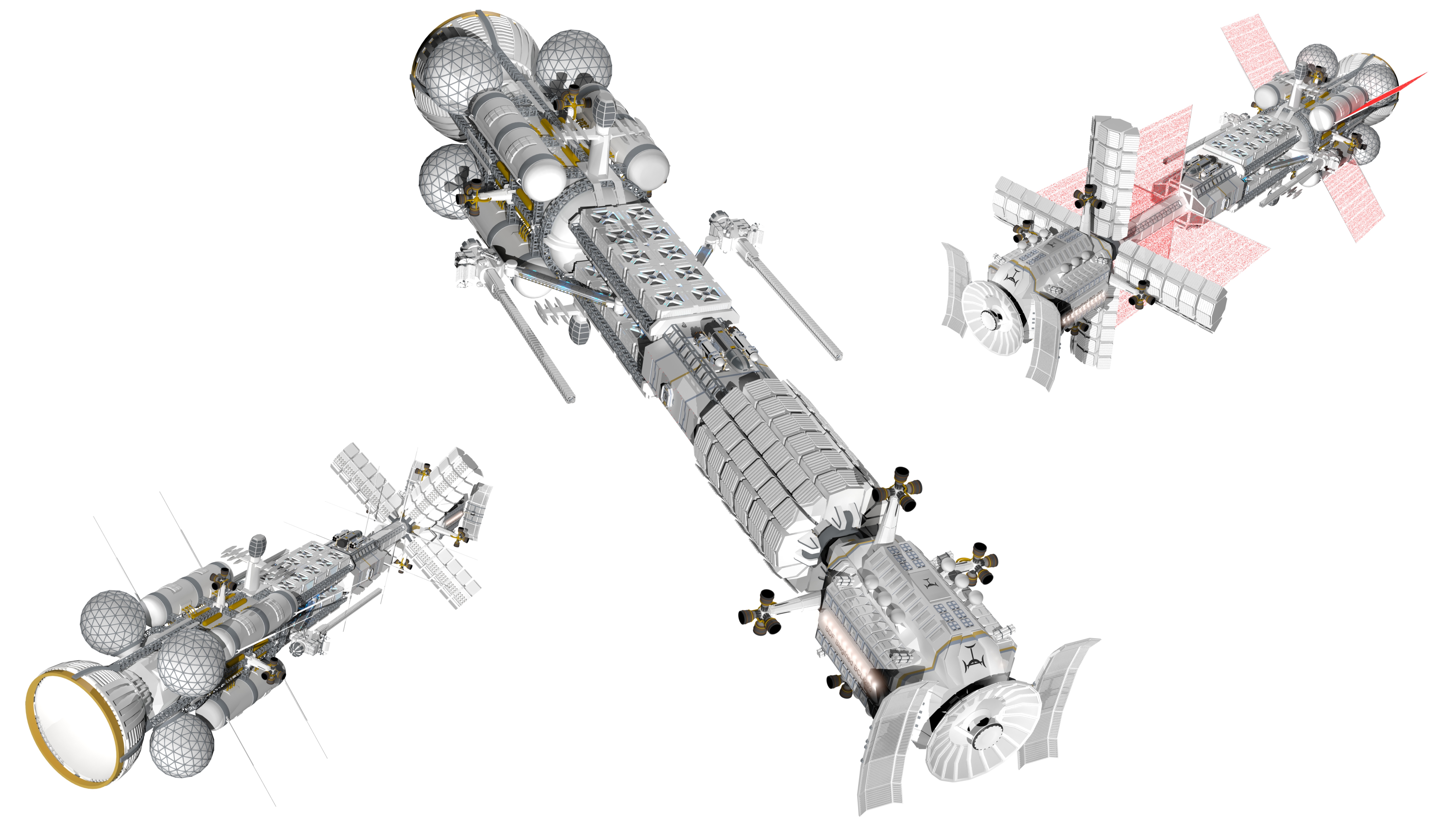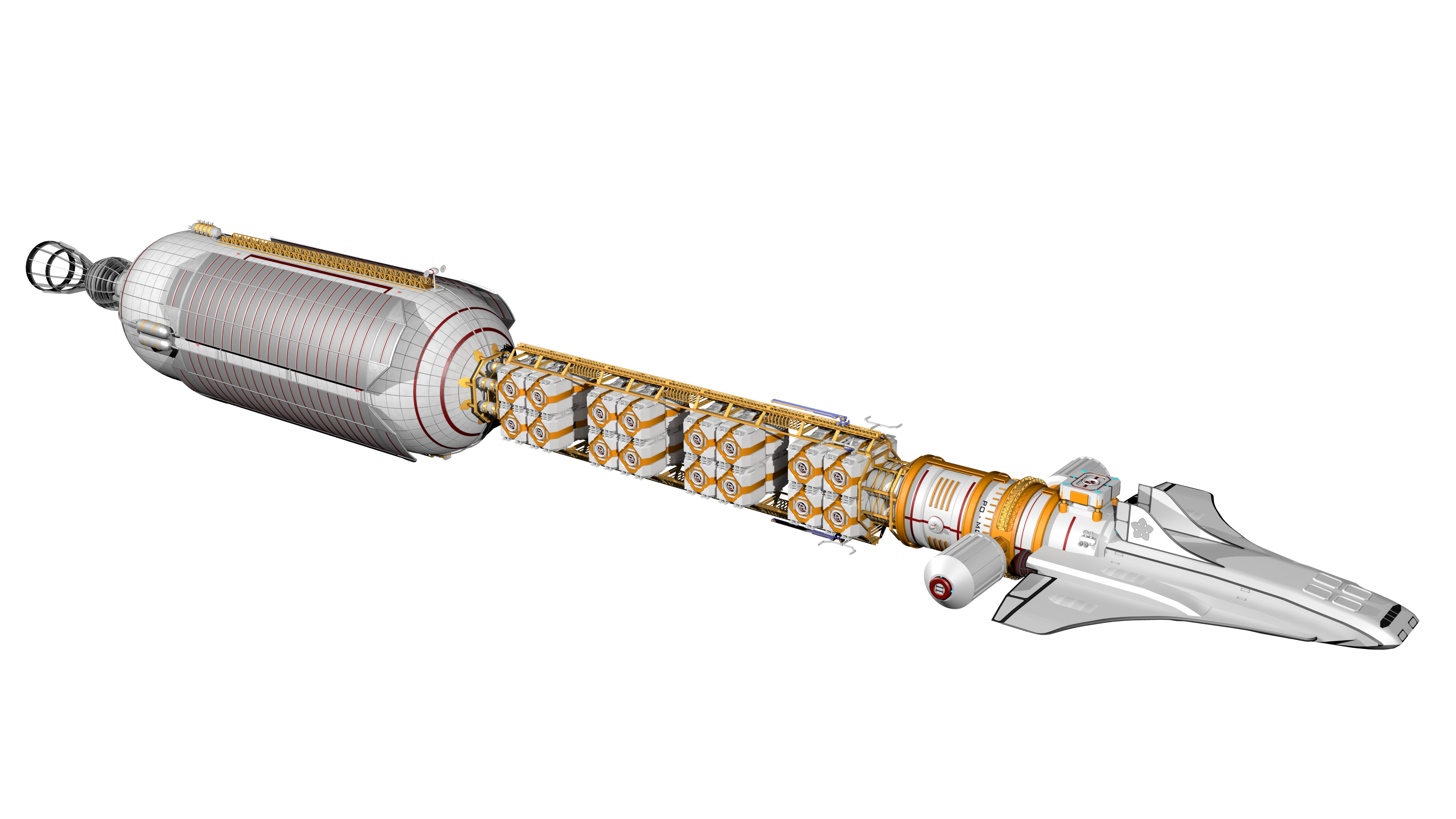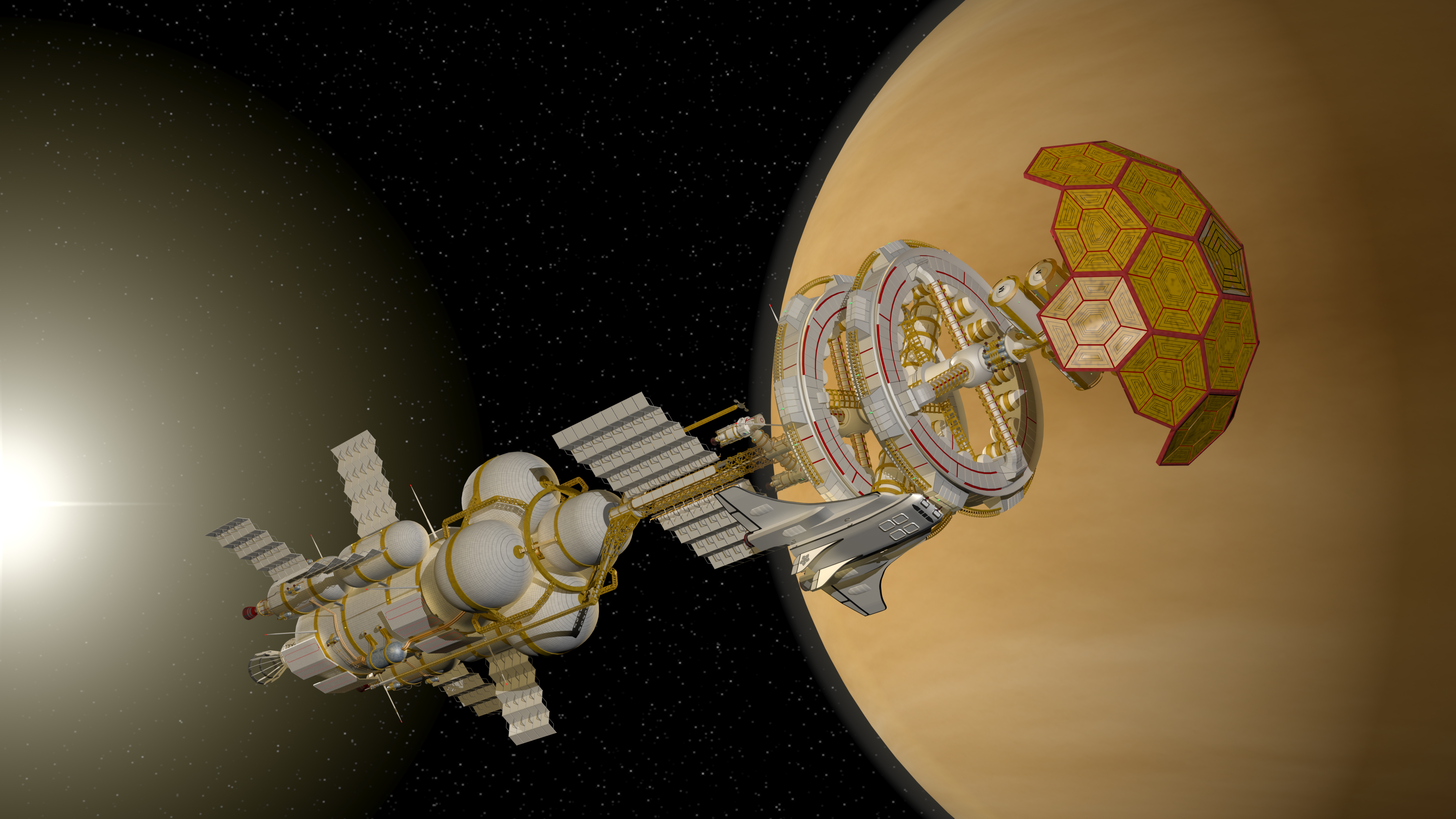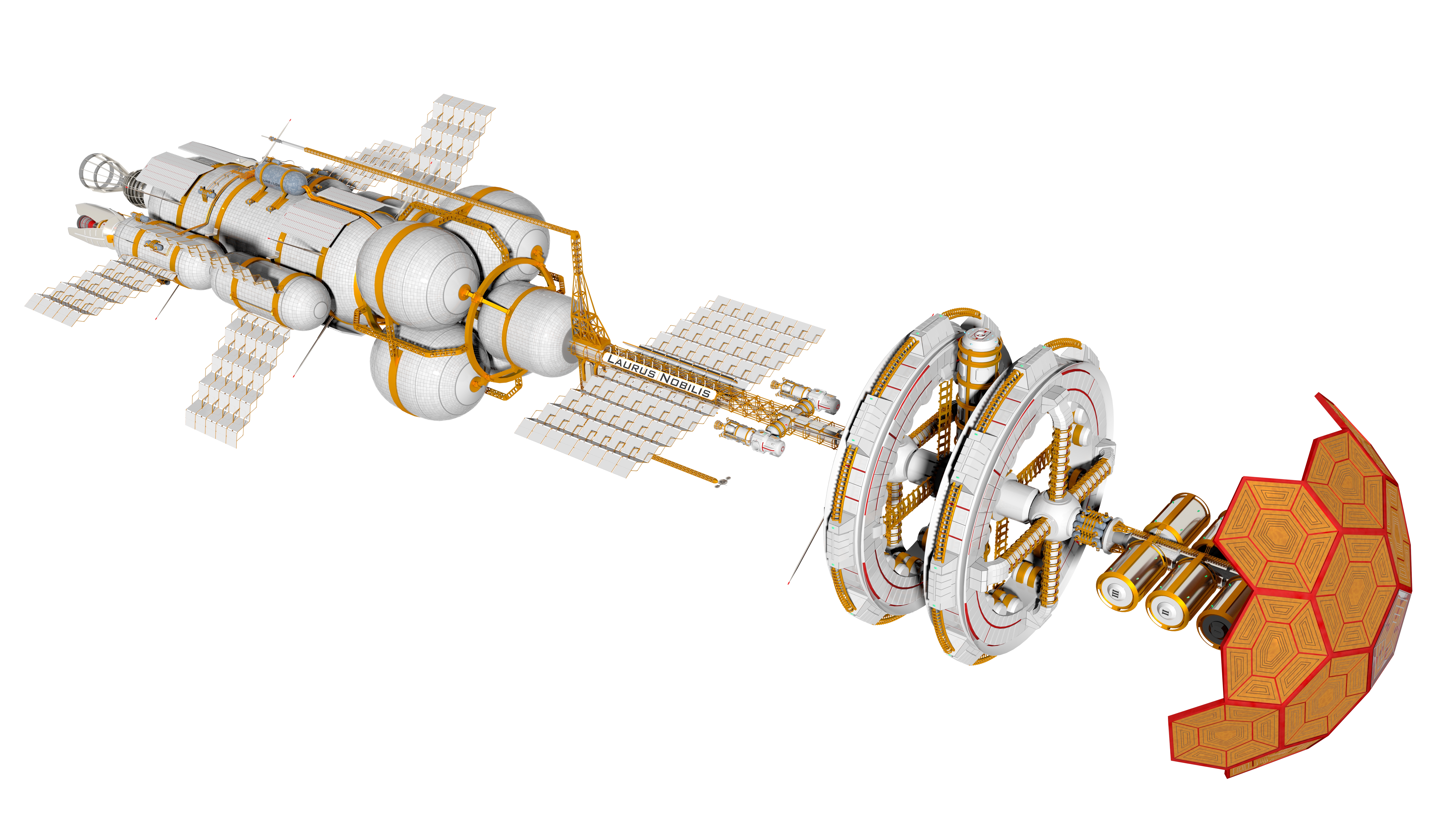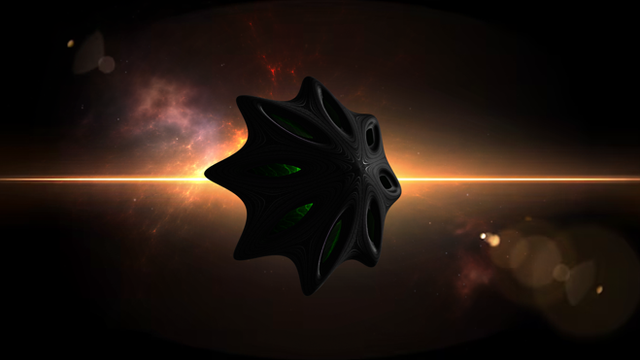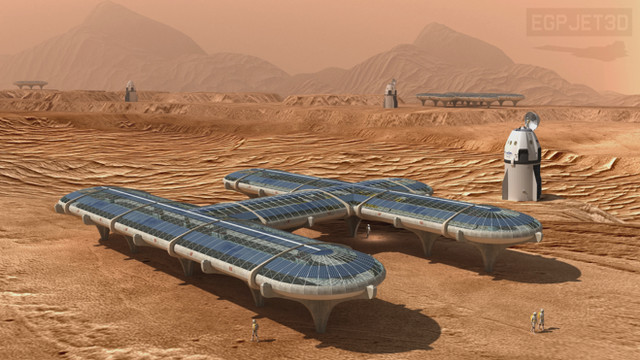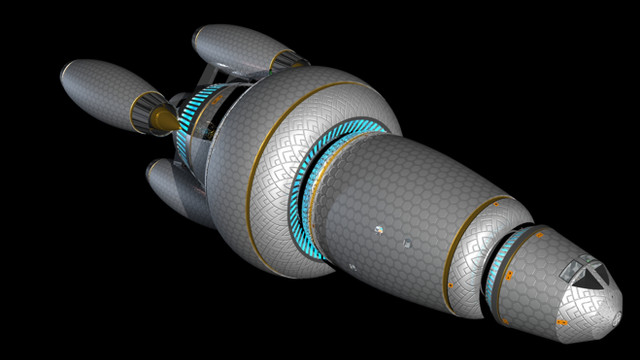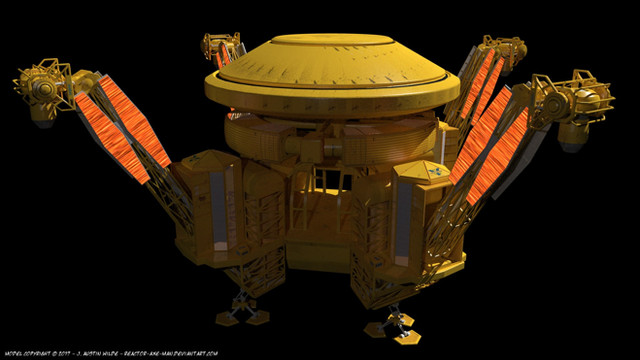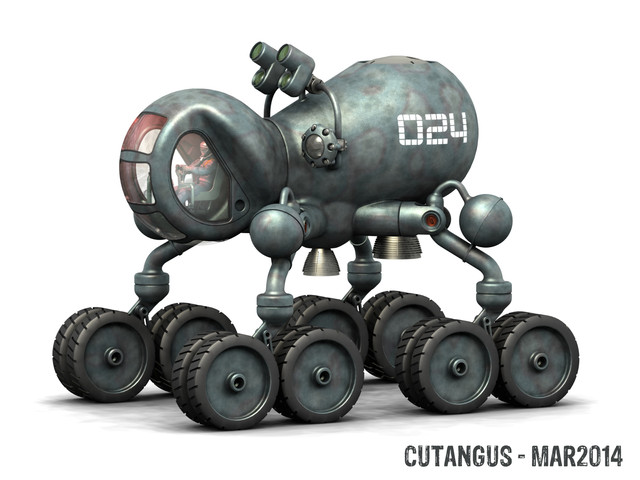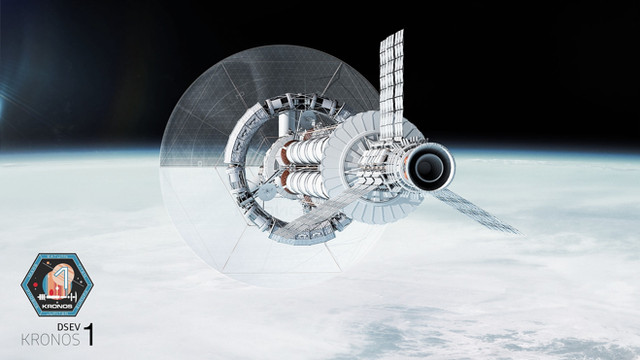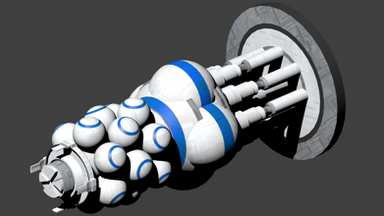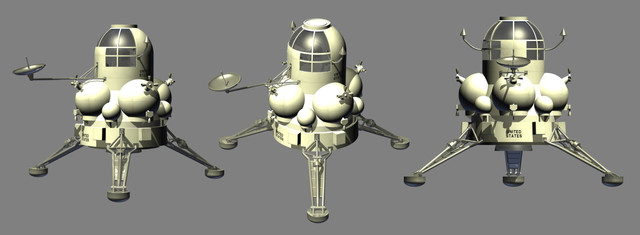HOME | DD
 Do-Mo — Sort of realistic deep space science ship 1
Do-Mo — Sort of realistic deep space science ship 1

#3d #3ds #big #centrifuge #comets #concept #drill #exploration #fusion #future #kuiper #model #nuclear #realistic #rocket #science #space #spaceship #venus #rocketpunk #plutonid
Published: 2015-11-03 01:03:41 +0000 UTC; Views: 19250; Favourites: 256; Downloads: 297
Redirect to original
Description
Length: 304mHeight: 56m
Width: 60m (94m with radiators deployed)
Dry mass: 3 850 tons
Full load: 8 000 tons
Complement: 20
Main engine: Magnetic Confinement fusion
Thrust: 50 KN
Fuel: He-3 - D
Propellant: Liquid hydrogen
Propellant supply: 4 000 tons
Mass flow: 0,14kg/s
Acceleration: 6,25 mm/s
Peak acceleration: 12,5 mm/s
Delta-v: 242,6 km/s
Side engines: 2x Open cycle gas core nuclear rocket
Thrust: 6MN (since both are angled at 5°, effective thrust is 5,7MN)
Propellant: Liquid hydrogen
Propellant supply: 4 000 tons
Mass flow: 60kg/s
Acceleration: 0,71 m/s
Peak acceleration: 1,42 m/s
Delta-v: 69,3 km/s
Thrusters
Hydrogen - Oxygen chemical rockets
Support vessels carried
2x Virga class
Laurus Nobilis class is a type of Venerian science vessel, built for extremely long survey missions into Kuiper belt, and scattered disc. Its mission is to reach Trans-Neptunian space, then to conduct close range scans of various comets and plutoids, as well as to send off away missions that will land and collect surface samples. Primary goal is to find and mark comets of desired size and composition, which will be repositioned closer to Venus in future missions.
Once launched, it would spend 165 days accelerating with its main fusion engine, followed by approximately 540 days of drifting, followed by another 165 days of slowing down. At that point the ship would be at its desired location, and the mission would begin. While surveying Kuiper belt objects, main engine would be offline, instead, its side, nuclear rockets would be used, to provide faster "hops" in shorter distances. Hopefully, before all propellant is used out, the ship would position itself near a suitable comet, and once there it would extend its large telescopic drill, which would suck in ice, which would then be processed into propellant, oxygen and drinking water when needed. Large machinery would be used for processing ice drilled from comets. Taking into account vast distance that this mission would take the ship and its crew, it is highly important that these "hops" and refueling sessions be timed correctly, since help is really far away. For the same reason, this ship is built with many redundancies, propellant is split among several large fuel tanks and its crew is prepared for higher than normal levels of maintenance and repairs. After 8 years, the ship would finally start its long journey home, giving this mission a total duration of approximately 13 years.
The most prominent feature in its design is a large, forward facing, shield, meant to protect the rest of the ship from various debris that might be encountered while traveling at high speeds, and chasing comets. Right under the shield is a section that contains 6 large separated hydroponics gardens. Plants inside are meant to provide additional food sources, as well as to assist with maintaining oxygen levels. Crew is housed in two large contra rotating habitat rings. Having taken mission length into consideration, measures have been taken to provide crew with good accommodations, and a large living space. Two Virga class support vessels are carried, which are able to get a closer look at certain objects, as well as to land and liftoff from comets and most plutonids. Excess heat is radiated with passive radiators, and while there are fixed radiators near the engine section, most are foldable, and can be hidden behind the forward facing shield. Other than its shield, this ship is very fragile, a measure that had to be taken to reduce weight, which makes the entire structure highly dependent to its external support struts. For the same reason its maneuverability is very low.
While there aren't many of them, several ships like this one are used at all times, covering various sections of Kuiper belt and Scattered disc, searching for appropriate comets, and conducting scientific missions at the same time. Not as capable as many warships within Sol, but they are still regarded as a highly useful ships, and even with their extreme mission durations, it's a great honor to serve on these ships.
Related content
Comments: 24

👍: 0 ⏩: 1

👍: 1 ⏩: 0

👍: 0 ⏩: 1

👍: 0 ⏩: 0

Well, I wouldn't want to accidentally spike something by hitting it straight on. With a spherical shape, I think it's more of a possibility to deflect at an angle, even something that hits near the center. But I'm no expert so who knows.
👍: 0 ⏩: 0

I like this. I think it's very realistic. I love that you thought to ad the shield in front and even made it round to cause deflections rather than collisions.
👍: 0 ⏩: 2

Wouldn’t a cone shape be better at deflecting?
👍: 0 ⏩: 0

Thank you
While speaking of realism, I completely forgot to add any radiation shielding around the engines, which is a big miss. I imagined the shield to be made from some type of ceramics, maybe even something that could be polarized for extra deflection.
Sometimes I get a desire to redo this one, and fix the errors, or improve it since my skill got a lot better since making this, however, I still get surprised by this being my most popular design, so I feel any changes to it might ruin it.
👍: 0 ⏩: 0

I was so taken by the design and look of the Laurus Nobilis, which I happened upon on a search offsite, that I employed it in this artwork, which I hope you find an interesting effort to expand upon your creation:
Thank You!
👍: 0 ⏩: 1

Ha! Didn't expect this! And it is interesting, I'm usually pretty bad at actually making scenes for my ships, so it's nice to see something like this. And thank you for the kind words
👍: 0 ⏩: 1

I'm glad you approve!
Since I don't render myself, I'm always looking for good ships such as yours to compose in visually interesting scene.
Thanks again!
👍: 0 ⏩: 0

A well-conceived spaceship concept! I especially like the high amount of background information, which gives a good idea on the mission this ship is designed for.
Having a secondary, independent engine may be vital for vessels far out at the edge of the solar system. This will give the crew a change to return, in case the main engine fails.
👍: 0 ⏩: 1

Well it's always fun to imagine some background story while I'm making them, and I like to make them fit in with each other in some combined universe (which will hopefully be more apparent within the next few days 
And yes, secondary engine really does help in an emergency, but the real reason why I put those gas cores there is...well time
I mostly copied the fusion engine from a realistic remaking of Discovery, which has great specific impulse, but low thrust, which is OK if you're going on long distances, but while there(Kuiper belt, Scattered disc...), it would really slow down exploration, and a lot less objects could be approached in the same time line.
I read that an average distance between large objects in Kuiper belt is around 180 mil kilometers, so while this fusion engine has a much higher delta v, it would take it TWO MONTHS to accelerate to 35 km/s, and by that time it would already be half way there, and would need to turn around to slow down. On the other hand, gas cores can reach the same speed in half a day, and finish the trip in just about two months, so half the time it would take to do so with a much more efficient fusion engine. In normal circumstances that wouldn't be too viable because of fuel constraints, but hey, that's why it has the drill, and there's fuel all around it.
It's fun to imagine that big science ship, just hopping from one comet to another, sticking around each one to do science stuff, and then moving on, maybe from time to time, send out away missions to plutoids. How much could be learned from just one trip...
👍: 0 ⏩: 0

Sort of realistic, sort of freakin awesome.
Beautiful work man, I love the well thought out design.
Lot of heart went into this one.
g
👍: 0 ⏩: 1

One of the nicest comments I ever received!
👍: 0 ⏩: 1

Hey man, it's nice work, just calling em' like I see em'.
Keepem' coming!
g
👍: 0 ⏩: 0

You mean the big orange one? That's more of an anti-debris shield
Why do you think it needs to be bigger?
It might not be obvious from this angle, but it really does cover the whole thing, here's a quick ugly render from top Imgur link . Only the foldable radiators are sticking out, and a tiiiny bit of docking port, but that part can also extend and retract somewhat.
👍: 0 ⏩: 1

I thought it was a heat shield for aerobraking.
Does a spaceship really need a anti-debris shield? How fast is it supposed to travel?
👍: 0 ⏩: 1

It's speed would be above 100 km/s, which does put it at risk of debris collision, also, it's very light, so most of it is frail and unprotected. And given that it's mission is to chase comets, I imagine it would run into a bunch of debris
👍: 0 ⏩: 1

Oh, a debris sheild is required for a comet chaser. Thank you.
👍: 0 ⏩: 0
